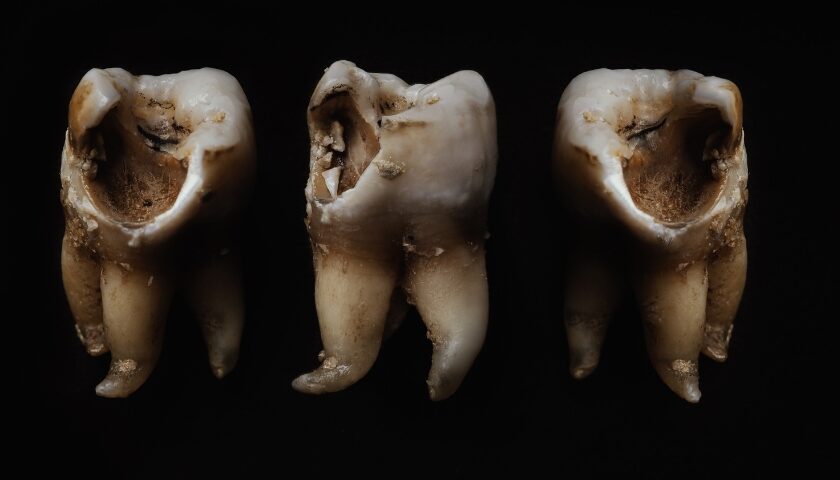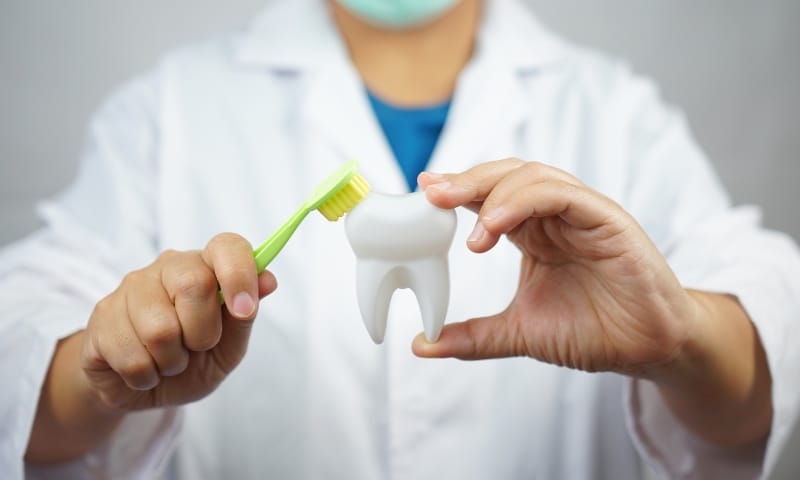Stages of Tooth Decay

How Long After Teeth Whitening Can I Drink Alcohol
May 13, 2024
Is There a Cure for Tooth Decay?
May 27, 2024Tooth decay is one of the most common causes of tooth pain. It begins when the enamel starts to break down, creating pockets of decay on the tooth surface. This decay is caused by acidic damage produced by bacteria living in plaque, the sticky film formed by proteins in saliva metabolizing sugary foods left in the mouth. Some forms of tooth decay can be managed by maintaining good oral care habits and regular visits to your trusted dentist in Olds, AB. The following image can help you identify and understand tooth decay, so you can take steps to prevent it.
Stage One: White Spots
The first stage of tooth decay starts with a sneaky culprit – plaque. This sticky film harbors bacteria that love feasting on sugar in your food. As they munch away, they produce acid. This acid slowly dissolves minerals in your tooth enamel, creating those chalky white spots. The good news? At this early stage, with proper care, you can reverse the damage! Talk to your dentist about using the right brushing technique, fluoride toothpaste, and a topical fluoride treatment to fight back and keep your smile healthy.
Stage Two: Enamel Decay
In stage two of tooth decay, the enamel begins to break down beneath the tooth’s surface. At this point, the natural remineralization process is unable to restore the enamel and minerals properly, leading to the formation of a lesion within the tooth. As the decay progresses, the tooth’s surface is at risk of breaking, which is an irreversible condition. If a tooth does break, it is crucial to seek dental attention immediately.
Stage Three: Dentin Decay
Stage three of tooth decay is known as dentin decay. If left untreated, bacteria and acids continue to dissolve the enamel, and the lesion can reach the dentin, which is the layer between the enamel and the pulp. Once decay moves to the dentin, the pain intensifies, and sharp pain may be felt in the affected tooth. As more sub-surface enamel weakens due to the loss of calcium and phosphate minerals, the enamel can collapse, forming a cavity. At this stage, a dental filling is typically needed to restore the tooth.
Stage Four: Involvement of The Pulp
The pulp is considered the tooth’s center and is composed of living tissue and cells known as odontoblasts. These cells produce dentin, the connective tissue between the enamel and pulp. If the pulp becomes infected with bacteria, pus forms, which can kill the blood vessels and nerves in the tooth, resulting in a toothache that causes constant pain. At this stage, root canal therapy is the most common course of treatment.
Stage Five: Abscess Formation
Abscess formation is the final stage of tooth decay and is by far the most painful. When the infection reaches the root tip of the tooth, the adjacent bones also risk becoming infected. This can cause the gums and tongue to swell, affecting speech and increasing the risk of other diseases. At this stage, additional oral surgery may be necessary to address the severe infection and prevent further complications.
Stage Six: Tooth Loss
If left untreated at each stage of tooth decay, the tooth will ultimately be lost and may require extraction.
Preventing tooth decay is manageable with the following measures:
- Maintain a robust oral hygiene routine – use toothpaste and mouthwash containing fluoride, and enhance your brushing technique with an electric toothbrush. A consistent oral care routine is essential for maintaining oral health and preventing tooth decay.
- Limit consumption of sugary foods and beverages, and avoid snacking between meals.
- Stay hydrated by drinking water regularly. Adequate hydration helps stimulate saliva production, which aids in nourishing tooth enamel and cleaning the mouth.
- Schedule regular checkups with your dental professional. Routine dental visits play a crucial role in preventing tooth decay and maintaining overall oral health.
Maintaining good oral hygiene habits and visiting your dentist regularly are the best ways to keep your smile healthy and cavity-free. Early intervention is key for preserving your natural tooth structure and avoiding more extensive procedures. Although a complete “cure” for advanced decay may not exist, with proper care, you can prevent future cavities and keep your smile bright for years to come.




